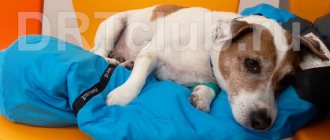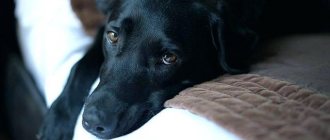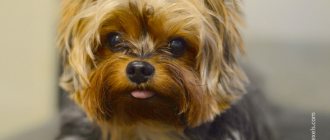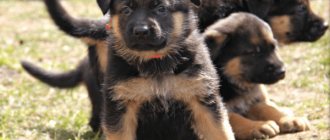Cataracts in dogs are clouding of the lens of the eye, accompanied by decreased vision up to complete loss of light perception. The lens is an indispensable element of accommodation of the eyeball. It looks like a biconvex lens, is located in the recess of the vitreous body, loosely adjacent to it and forming a capsule. With age, the lens tissue thickens and becomes less elastic. Either myopia or, most often, farsightedness develops. Also one of the most common diseases of the lens is cataract.
Accepting the diagnosis
After a fateful visit to the veterinarian, the owners begin to panic and have a strong desire to get rid of their defective pet. Drive away unworthy thoughts: the dog’s keen hearing and well-developed sense of smell will help him find directions in the dark world and, as before, delight his owners with his stay in the house. Of course, you will have to give up some types of training and games, but after a difficult transition stage, the dog’s life will return to normal.
Take blindness for granted - feeling your positive attitude will help your dog recover from the shock faster.
Security issue
While the dog is learning to live in a new way, everyone in the household should take care of its safety. First of all, you should pay attention to your pet’s usual routes: to the lounger, bowls of food and drink. Try to remove all items that may interfere with reaching your destinations, and ask household members to maintain order: do not scatter things, do not rearrange furniture. Remember: even a pair of shoes left on the way from the room to the kitchen can confuse the dog and aggravate his psychological state.
If you notice that your dog bumps into cabinets or walls several times a day, get a special “cane”: a vest for animals, to the front of which a protective half-ring is attached.
Symptoms
Clumsiness Colliding with objects Inability to find food and water Inattention, excessive sleepiness Nervousness and irritability Loss of interest in games Losing oneself in one's surroundings
When your dog is blind and you, not knowing what to do, are looking for advice on this topic on the Internet on forums, we recommend not to self-medicate or experiment on your beloved pet. The fact is that there are many causes of blindness in an animal, and the consequences of your experiment may disappoint you and your family.
Toy Terrier Disease - Compulsive Behavior (Onanism)
Due to the peculiarities of the nervous system, the toy terrier is prone to masturbation. As a rule, the object becomes a soft toy or the owner’s slippers; the foot of any member of the household will do. The owner, noticing the behavior of his toy terrier with slippers for the first time, is lost and does not know how to react. You need to carefully take away from the terrier the object with which he is performing the act and it is better to throw it away (for him to see). If you remove this thing, the terrier will remember where it is and will stand and whine for hours, exhausting the nervous system of itself and you.
The first attack of compulsive behavior in toy terriers occurs at about 5 months, do not panic, do not shout at the dog. Try to distract him with a walk or game. If your Toy Terrier is not suitable for breeding, castrate him; this procedure will help solve an additional number of problems. In the absence of daily walking, the toy terrier relieves himself in the tray; at about 6 months he will begin to mark the territory, as a rule, these are corners in the apartment or chairs.
Punishing and trying to wean a toy terrier will not lead to a positive result. After castration, the terrier will become calmer, less aggressive, and the unpleasant habits described above will become a thing of the past. Diseases and recommendations for the poodle
the dog is blind
The same uniform should be put on the dog when going to the country or on a visit - then your pet will be able to lead a normal lifestyle without requiring increased attention.
We are looking for alternatives
Loss of vision will force the animal to develop all its senses, and the owner’s task is to help the pet learn to navigate space with ease.
Make it a rule to talk to a four-legged blind man - the intonation of your beloved owner’s voice will make it easier to move and will stimulate movement. Communicate with your dog at home and on the street, praise him for successfully avoiding obstacles and warn him about danger: simple manipulations will allow the animal not to feel loneliness and confusion. Learn to comment on your actions, even the most harmless ones: suddenly an outstretched hand may seem like a source of danger to the dog, and the breeder, who was simply petting the animal, will end up being bitten.
To develop your dog’s natural instincts, use toys - puzzles with treats hidden inside, squeakers and any sound toys. It is important to prevent your pet from withdrawing into itself - it will be really difficult to cope with blindness and psychological depression at the same time!
Just in case…
A blind dog is always at high risk. If disoriented in unfamiliar territory, a blind pet will not be able to find its way home and will die on the street. If possible, implant a chip in your dog or buy a collar with a GPS navigator, try not to let your dog off the leash, avoid contact with unfamiliar animals - these simple precautions will help prevent misfortune and guarantee a blind dog a long and happy life.
Dogs
All diseases that lead to vision loss ultimately block the retina. This could be the well-known cataract, glaucoma, age-related changes. Blindness in a dog can be congenital or develop as a result of a brain disease. With a routine external examination, it is impossible to identify the cause of blindness.
Causes of blindness in dogs
The general symptoms of blindness are the same for most diseases. The cause may be injury or pathology of the eye or a nervous disorder: • cataracts – a disease of older animals: • increased intraocular pressure, also known as glaucoma, which can occur in a latent form for some time; • optic neuritis; • corneal damage; • inflammation of the eye membrane; • detachment and degeneration of fiber as a result of hormonal disorders of the thyroid gland, adrenal glands, diabetes mellitus; • uveitis.
Symptoms of Dog Blindness
Dogs' eyesight is not naturally very good. Animals rely more on their sensitive sense of smell and hearing. These feelings become even more acute as vision decreases or is lost, causing the dog to feel relatively confident in familiar surroundings. You can detect a serious vision problem by observing your pet. • First of all, the change in gait attracts attention. The dog tries to raise its paws too high, especially when moving up the stairs, walks very carefully and often bumps into various objects that get in its way. • The dog avoids active games and, when walking, tries to stay away from other dogs with whom a conflict may arise. • On the street, the animal keeps its head close to the ground, trying to navigate by smells. • The dog stops responding to commands with gestures and in general its gaze is not as attentive as before.
Diagnostics
How to check your dog's eyesight at home? The symptoms described above are a reason to test her vision more carefully: • you can place several objects on the floor of the room, turn off the lights and call your pet. A dog in an unfamiliar environment relies more on smell, since in the dark its vision is even weaker than in the light and moves cautiously. Turn on the light and watch. If there is more confidence in the dog’s movements, then, presumably, everything is in order; • direct a beam of light from a flashlight into the dog's eye and see if the pupil constricts. This is not a 100% accurate test, but if the pupil does not respond, then this is a cause for concern; • check how your pet reacts to a threat. The dog should at least somehow react to your sharp threatening gesture and recoil. If this does not happen, then the dog does not see; • When walking slowly, try guiding your pet through an obstacle course. Only an ophthalmologist can reliably identify signs of blindness in puppies. In young dogs, congenital blindness occurs when they are approximately seven weeks old. When buying a puppy, be sure to ask the breeder for documents about the health status of the parents, since many eye diseases, such as night blindness in dogs, are inherited. You can test your pet yourself at home:
• wrap cotton wool on a thread and swing it in front of your muzzle. If the puppy reacts, at least with an eye movement, then everything is normal; • cotton wool will be replaced by a laser pointer beam.
Disease - gastritis
This terrier has a poor appetite, which greatly worries its owners. It is difficult to accustom him to a diet. Food in a bowl can sit all day. The owner begins to try to feed the dog anything, and he, in turn, waits for something tasty to be given, sausage, sausages, cheese, etc. are used. That terrier, trembling and blinking his eyelashes, slowly and reluctantly eats what was offered. This behavior of humans and dogs soon leads to gastritis. It can begin suddenly, accompanied by periodic vomiting, diarrhea, and pain. The toy terrier whines and arches his back. Often, after an outbreak of acute gastritis subsides, the disease becomes chronic.
In the future, the pet requires a lifelong diet. Very similar symptoms and the same reasons (malnutrition) cause gastroenterocolitis. Based on gastroscopy, your veterinarian will give your toy terrier the correct diagnosis and prescribe treatment.
Types of cataracts
The disease is classified on several grounds:
By localization - marginal, layered, cortical, complete, nuclear. Over time, one form may be replaced by another as the focus of turbidity grows. In the third stage, any cataract becomes complete because it affects the entire lens.
According to the time of occurrence - congenital and acquired. Congenital develops in puppies even before birth against the background of intrauterine infection of the fetus or a severe infectious disease of the puppy. The first signs of cataracts are found in some cases in puppies immediately after opening their eyes at the age of 8-16 days. It is unreasonable to assess the quality of vision at this age, but examination at the time of congenital diseases would be appropriate.
By etiology - senile, toxic, traumatic, diabetic. Senile cataracts go through four stages - incipient, immature, mature and overmature. It develops slowly. Other species go through all stages of development much faster. The stronger the traumatic or toxic effect on the eyeball, the faster the cataract develops. Diabetes also accelerates the development of lens opacities. Consistency: soft and hard.
The most common varieties
The most common types of cataracts are worth taking a closer look at.
Anterior capsular - in the center of the lens there is a sharply limited white opacification. Posterior capsular - there is a slight clouding that has a round shape and a grayish-white color. Diagnosed in puppies and young dogs. Develops as a result of disruption of the formation of eyeballs in the embryonic period. Does not cause significant visual disturbance due to its small size.
Layered is the most common form. It occurs against the background of a disorder or dysfunction of the parathyroid gland, calcium metabolism disorders.
Traumatic - if the eyeball is injured, chamber moisture can penetrate the lens and cause clouding. In addition, the animal's intraocular pressure increases, which can lead to retinal detachment or uveitis - inflammation of the choroid of the eyeball. Most often, the following injuries lead to the development of lens opacification: bruise of the eyeball, bruise of the head, bite wounds of the muzzle and eye area. Separately, it is necessary to highlight thermal injuries - burns and frostbite. In dogs unadapted to cold climates, cataracts can develop due to hypothermia, and in brachycephalic dogs (pugs, bulldogs), breeds with short muzzles (boxer, bullmastiff, Pekingese, Shih Tzu) and northern dogs (Samoyed, husky, malamute) - due to resulting heat stroke.
Tectonic - occurs against the background of hypofunction of the thyroid gland, hyperfunction of the adrenal glands, atrophy of the gonads. Tetany is a convulsive symptom that occurs due to an imbalance of trace elements in the dog’s body. Metabolic disorders apparently also affect the performance of the visual organs. Radiation - occurs due to the impact of beta particles and neutrons on the lens.
Toy Terrier disease - hydrocephalus "dropsy" of the brain
Genetic predisposition, 18% of toy terriers are susceptible (progressive disease). Signs: convulsive seizures, fainting, depressed state. Sometimes, an increase in the size of the forehead is a sign of increased intracranial pressure. In toy terriers, the cause of hydrocephalus can be a traumatic brain injury (fall from a height).
Recommendations:
-drug treatment, medications are prescribed that slow down the production of cerebrospinal fluid.
- surgery. If it is successful, the disease stops progressing.
The dog is blind: reasons, how to determine vision loss, caring for a blind dog
Point it towards the puppy's front paws and see how he reacts; • Cover one of the puppy's eyes with your palm, and with the other hand make a sharp movement, to which the animal will either blink or try to evade. If you have reason to suspect blindness, contact your veterinarian. For a more in-depth examination of a dog’s eyes, the ophthalmologist has a sufficient number of tools in his arsenal. This includes ophthalmoscopy, the Schriemer test, ultrasound, measurement of intraocular pressure, gonioscopy, and electroretinography... As a result of a comprehensive study, the doctor will determine whether blindness in a dog can be cured.
Blindness in dogs: treatment
First of all, we note that vision loss cannot be cured, but this is not a reason to fall into despair, much less say goodbye to your pet forever. A blind dog's hearing and sense of smell will become even more acute, and this will allow it to live out its full life. You just need to pay more attention to the safety of the animal. Do not let your blind dog off the leash, walk away from aggressive dogs. You should not rearrange the furniture in the house - in this case, the dog will completely lose orientation in the home space. In the house you need to remove all objects that could injure a blind dog. Limit your dog's access to stairs, swimming pools, and very hot radiators.
Injuries
The primary cause of blindness is eye injury. Damage to the visual organ can occur during a fight with relatives, insect bites, or scratches from cats. A dog can damage its eyes from branches or fallen particles of earth. The danger comes from specks and debris that get into the eye of an animal sticking its head out of the window.
Breed predisposition
There is a breed predisposition to diseases that lead to vision loss: for example, Beagles, Basset Hounds, Cocker Spaniels, Great Danes, Poodles and Dalmatians are predisposed to primary glaucoma; In terriers, German shepherds, miniature poodles, and dwarf bull terriers, lens luxation is often observed, which is genetically determined; Retinal detachment is more common in Shih Tzu dogs.
Subscribe to our newsletter and get a free veterinary consultation
Thanks for subscribing!
Smell from the mouth
If your pet has bad breath, this is a reason to contact your veterinarian immediately. After all, a bad smell is a sign of illness.
If the dog does not have any diseases, then the cause of the smell is tartar or lack of care for the pet’s mouth.
What do we have to do:
- diversify your diet. Your pet's menu must include apples, carrots, and soft vein bones;
- To make it easier to remove plaque, give your pet tomato juice. At each feeding, add 1-2 tablespoons of tomato juice to your food and after 2 weeks you can easily remove plaque;
- take care of your pet's mouth. This includes regular teeth cleaning and tartar removal.
What colors can dogs see?
The retina of an animal's lens does not contain red-sensitive cones. The dog may perceive shades of this color in combination with others as white. The brightest colors for this animal are blue and yellow.
The dog sees gray tones well. Only this mammal can see the notorious 50 shades of gray. The structure (the presence of special light-sensitive cells) affects this feature. The rods in the retina are designed in such a way that the pet clearly sees gray and its shades.
What comes into view
A dog's field of vision is 70% larger than that of a human; it resembles an oval rather than a circle. And, what’s remarkable, the dog can see to the sides quite clearly.
So, as you understand, tuziki and balls do not have ideal, in our opinion, vision, but this is quite enough for them to satisfy their needs. It is not unimportant that their sense of smell, which is many times better than that of a human, helps them to have an idea of the surrounding reality.
Interesting information!
- Have you ever asked yourself the question - why, when you watch TV, the dog, frankly bored, does not fix its gaze on it? It turns out that the fact is that their eyes can perceive a frequency of 80 hertz, while modern TVs have a frequency of 50-60 hertz. The film seems to her like pictures flashing on the screen that do not arouse her interest. Modern TVs are designed for 100 hertz, so by purchasing modern equipment, you will have the opportunity to watch your favorite action movie in the company of a four-legged friend.
Recommendations for your Toy Terrier
WOLMAR WINSOME® PRO BIO BOOSTER Ca MINI - Calcium and vitamins for the toy terrier, especially for small breeds, for a puppy during the growth period.
WOLMAR WINSOME® COLLAGEN MCHC – For the proper formation and strengthening of the bones of the toy terrier, it will reduce injuries from falls and unsuccessful jumps.
WOLMAR WINSOME® PRO BIO GA-GLICAN – correct formation of the joints of the toy terrier and prevention of their injuries.
WOLMAR WINSOME® PRO BIO PRO HAIR – For coat and skin, in the off-season during shedding (makes ideal coat and skin).
WOLMAR WINSOME® ACIDOVIT – Prevention of gastritis in toy terriers due to improper feeding and stomach problems.
Structure of a dog's eye
The structure of the animal's organ of vision is similar to that of humans, but there are some differences. This is due, first of all, to its hunting purpose.
Structure:
- The cornea is a barrier that protects the lens from external influences. This is the first layer of the organ of vision. Reacts to light signals. In a healthy individual it is smooth and clean.
- Behind the cornea is the iris with the pupil and lens in the center. Older individuals are at risk of lens clouding.
- The last layer is the retina. The optic nerve connects it to the brain. The retina transmits signals from outside to the brain through nerve impulses.
The natural purpose of the dog - searching and hunting - predetermined the functions and structure of its eyes.
The dog can quite accurately determine the distance to a certain object. It all depends on the rods, which are located on the retina in the center, where a person’s macula is located.
Disease - atlantoaxial instability
The disease is genetically inherited by the toy terrier and dachshund. The anomaly is associated with improper formation of the articulations of the first cervical vertebrae in the toy terrier, which leads to compression of the spinal cord. Frequent symptoms are severe pain, depressed state, head fixed to one side, paralysis in the cervical region of the toy terrier. Diagnosis is made based on x-rays at a veterinary clinic. An effective treatment result is achieved by surgical stabilization of the spine; subsequently, a special corset is attached to the neck, which ensures the immobility of the vertebrae in the cervical region. An unfortunate fall can provoke illness in a toy terrier.
Differences with human vision
The four-legged friend can navigate equally well in the daytime and at night. However, his visual acuity is not very good. The macula, located in the central part of the retina of the human eye, allows a person to see clearly at any distance. Animals do not have such a spot, so the pet is farsighted. He does not see objects closer than 35 cm clearly.
A dog's color sense is many times worse than a human's. A small number of cones in the retina of an animal's eye makes it color blind. This disadvantage is compensated by a good sense of smell.
The special placement of the eyes on the animal's skull determines its field of vision. Some breeds can have a viewing angle of 250°; in humans it is 60ᵒ less. But this doesn’t matter to the dog; if it doesn’t see something, its sense of smell kicks in.
Dogs clearly recognize moving objects. This is facilitated by light-sensitive rods located in the retina of the eye. The animal does not notice static objects.
The eye of a four-legged friend perceives image transmission with a much lower frequency than a human one - 80 Hertz, which is 20 units less than the capabilities of the human organ of vision.
Dogs' eyes are susceptible to the same diseases as human eyes. They require attention and systematic care.
The structure of a dog's organ of vision is practically no different from that of a human. But small differences make a dog’s perception of the world completely different from that of a human. It all depends on the purpose of the animal to be a bloodhound and a hunter. Vision is not the main sense for a dog’s worldview. Depending on the breed, the main senses for this mammal are smell and hearing.
Lily and Maddison
From birth, Lily had a rare deviation in the structure of her eyelids: her eyelashes were directed inward, constantly scratching her eyeballs. The owner did not pay attention to the suffering of the animal and started this disease. When she was taken to the vet at the age of one and a half years, it was already too late, her vision was lost.
It seemed that her normal dog life was over, but when she was brought home, unexpectedly for everyone, her friend, a Great Dane named Madison, took on the functions of a guide and began to lead Lily everywhere with him.
It's amazing how these dogs move - blind Lily gently touches Maddison and the two of them go where Maddison leads. Dogs move a lot, play actively, and lead a full life. Thanks to her faithful guide friend Madison, Lily behaves so naturally that casual witnesses observing their behavior do not immediately understand that this dog is blind. Dogs use their own language and “talk” a lot in voices of different pitches when they need to solve their problems. These two dogs also sleep next to each other, curled up in a ball. Lily never leaves her friend Madison, who has not taken his eyes off her for more than 5 years.
What kind of vision do dogs have?
There are many assumptions about what kind of vision dogs have. In fact, a dog's vision is as sensitive as that of any other hunter. The dog has a wide field of vision. The color itself is not particularly important.
Dogs are better than people at detecting even small movements at a distance. However, at close range they see worse than us. A dog's eye is much flatter than a human's. Normally, the shape of the lens changes, increasing the length of the focal length, but this does not happen as effectively as in humans. The light sensitivity of a dog's eye is higher than that of humans, but it is much more difficult for it to distinguish completely motionless objects at any distance.
Peripheral vision varies significantly between breeds. In general, it depends on the anatomical location and section of the eye itself.
All shades of gray
It is a little misleading to believe that dogs have black and white vision. In general, dogs have color vision, but not in a pronounced form. Color vision is not as important for predators as it is for animals that depend on colored berries, brightly colored fruits, seeds and nuts to survive. The dog's eye has a common structure, typical of all representatives of the order of carnivores. The retina contains many light-sensitive cells called rods. It is these cells that reflect everything seen in shades of white and black. The rods are sensitive to light even at low light levels. Special color vision cells - cones - are found in rather small numbers in the retina.
The pupils of a dog's eyes have the ability to dilate greatly to capture as much light as possible, increasing the quality and efficiency of night vision.
The lacrimal glands protect the cornea from possible drying out. Dogs have a third eyelid that is permanently covered by the lower eyelid. Its main task is to protect and cleanse the eye from external pollution.
Deterioration of vision
Sooner or later, owners begin to notice that the dog is losing its vision. In order to cast aside all doubts or, on the contrary, confirm your fears, you need to know how to check your dog’s vision at home. You can move small gray objects near the dog, for example, roll balls on the floor. Since dogs react acutely to movement, a dog's calm reaction and inability to focus his gaze in the correct direction of an object may indicate problems with vision. Vision loss in dogs is usually accompanied by other physical manifestations of the disease. Redness of the eyes, clouding of the lens, pus, bleeding, itching, anxiety, loss of orientation in space - all this may indicate the possible onset of blindness. Such an animal must be shown to a specialist in a timely manner and all instructions prescribed by the doctor must be followed. It is also worthwhile to qualitatively diversify the diet and surround your pet with double love and affection, so that he calmly gets used to a new unusual way of life in a world of darkness.
Sharik, are you nearsighted or farsighted?
The answer to the question - what kind of vision do dogs have - would not be complete if we did not consider visual acuity. Although this factor cannot be called decisive.
Instincts play a big role in forming an idea of the surrounding reality. We are talking about dogs, and they are known to be predators, which means that if a moving object enters their field of vision, they need to catch it. It doesn't matter who is in front of them, if the object is 600 meters away and doesn't move, it will be the furthest object she can see. The animal notices his presence, but there is no interest in him. If an object is set in motion, the dog is able to see it, even if the distance between them is 900 meters. Therefore, the warning that running away from dogs is dangerous cannot be ignored. Moreover, the outlines of an object located in the distance will be clear and distinct, but the bowl in front of Tuzik’s nose may seem like just a blur.











